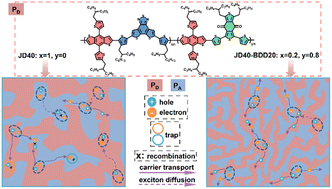Random copolymerization strategy for non-halogenated solvent-processed all-polymer solar cells with a high efficiency of over 17%†
Abstract
With the innovation of new materials, the power conversion efficiencies (PCEs) of all-polymer solar cells (all-PSCs) have been boosted to over 17%. However, most of them are processed with toxic halogenated solvents instead of non-halogenated solvents, which mainly stems from the difficulty of implementing a favorable active layer morphology via the latter. Here, we report a donor polymer named JD40-BDD20 by using a random copolymerization strategy for non-halogenated solvent-processed all-PSCs. The incorporation of the 1,3-bis(4-(2-ethylhexyl)thiophen-2-yl)-5,7-bis(2-alkyl)benzo[1,2-c:4,5-c′]dithiophene-4,8-dione (BDD) unit endows JD40-BDD20 with improved solubility, suitable pre-aggregation and crystallinity, and superior miscibility with PJTVT, compared to JD40. Consequently, a favorable morphology with a suitable domain size was achieved for a JD40-BDD20:PJTVT device processed with o-xylene (o-XY), contributing to improved exciton dissociation, balanced charge transport, enhanced charge extraction, and decreased charge recombination and energy loss (ΔEloss). Eventually, a prominent efficiency of 16.35% was achieved for the JD40-BDD20:PJTVT device, which was processed without annealing. In particular, when choosing PA-5 as an acceptor, the PCE was boosted to 17.21%. This work confirms that random copolymerization can be a very useful strategy by which to synchronously regulate the solubility and crystallinity of the polymer. It also demonstrates that JD40-BDD20 is promising to become the “workhorse” donor for the field of all-PSCs, and provides a promising avenue by which to achieve an optimal domain size in all-PSCs processed using non-halogenated solvent.



 Please wait while we load your content...
Please wait while we load your content...